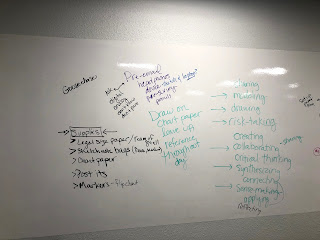During the past few months, I have been reflecting
a lot about documenting learning and how technology can help with that process. For several years, I have been interested in using formative assessments to make instructional decisions, and I know there are connections between the two, so now, I'm reflecting on this year's experiences and trying to put all of these learning-pieces together.
My Knowledge Base
John Hattie's work and
his three feedback questions helped me solidify understandings about effective feedback and how/where to infuse feedback into the learning process. In
The Google Infused Classroom, Holly Clark and Tanya Avrith share related ideas when they discuss assessment for/as/of learning. In their book, they also provide ways to make thinking visible and discuss how technology can amplify the learning process, and they reference the
Project Zero Thinking Routines. The work from
Silvia Tolisano and
these posts have
also inspired a lot of reflections on
documenting for/as/of learning. (Silvia also creates fabulous graphics and sketch notes, and I'm looking forward to her
upcoming book.) All of these thoughts about learning, feedback, and thinking routines are swirling in my head!
Blending Ideas
Holly and Tanya include a lot of ways to use technology to make thinking visible, so I'm going to try to do the same. I work with adult learners, but I'll begin with some of the strategies I used in my classroom. By the way, one big eye-opener in their book was the importance of learning from others to shift thinking. It's OK to have "public" posts for all to see, and that is definitely a shift in my thinking. Yes, some kids may copy answers, but others may think, "Oh, that's what she meant!" and formulate their own responses.
See-Think-Wonder
One of the first thinking strategies I tried was "What do you notice, and what do you wonder?" We even tried this idea with trigonometry vocabulary words on day 1 to illustrate that a lot of pre-calculus would be based on concepts you already know! (Trying to activate prior knowledge.)
Here's a description of the
See-Think-Wonder routine, and
here's an example of the routine being used in a health class. I always used the "Notice and Wonder" questions, but I like the structure of See-Think-Wonder, so I'm going to add the third question when I use this routine now.
When I tried this activity in class, I only had students share responses with each other and then "popcorn" out a few answers. In the video linked above, the teacher created a graphic organizer for his students, used think-pair-share for students to compare their responses, and then had a final debrief with a show of hands.
Options with technology...
Instead of simply observing an image, listing a few see/think/wonder statements, and sharing with a neighbor, how could technology be used to amplify this process?
- You could use comments in Google Docs, and I have used this notice-wonder activity in my sessions. Students could choose their preferred image, and they could reply to each other's comments.
- You could use a Padlet board to collect comments from each student, and with the new "shelf" option in Padlet, you can create the see-think-wonder prompts as columns.
- If you didn't want the kids to see each others' responses, you could use Google Drawings to create a graphic organizer and share as a template in Google Classroom (or "force" a copy for each individual.)
- Another option if you wanted individual responses: you could use a Google Form to collect all responses.
I can see benefits to both the individual and shared responses...it all depends on the activity. BUT by using technology, you have amplified the process because you are able to hear from every student ("Even the quietest student has a voice!"), responses are documented, and if students can see all of the work, they can learn from and provide feedback to each other.
And with adult learners?
My friend Katie recently used
Mentimeter for a faculty poll, and the responses are below.
I think the See-Think-Wonder strategy would be an excellent debrief after this type of activity, and I think it would help educators understand how technology could amplify the learning/feedback process. A few things I hope the participants would see, think, and wonder:
- There were 184 entries, so the entire faculty had a chance to respond.
- How long would it take for you to go around the tables and ask 184 people to answer the question?
- The most common responses/trends are evident. (The largest words received more responses.)
- How long would it take to see trends if responses were on post-its or slips of paper?
- If you couldn't immediately think of a response, you could see what others said to give you ideas.
- How could this tool/strategy be used with your class or team? What are the benefits? What are the drawbacks?
After working on this post today, the ideas are still swirling in my head, but I really like the idea of taking visible thinking routines and looking at tech-options. I firmly believe that you don't use technology for the sake of the bells-and-whistles, but I feel, at least in this case, the use of technology really could amplify the learning/feedback process.
What are your favorite thinking routines? I would love to see if technology could facilitate the process!













